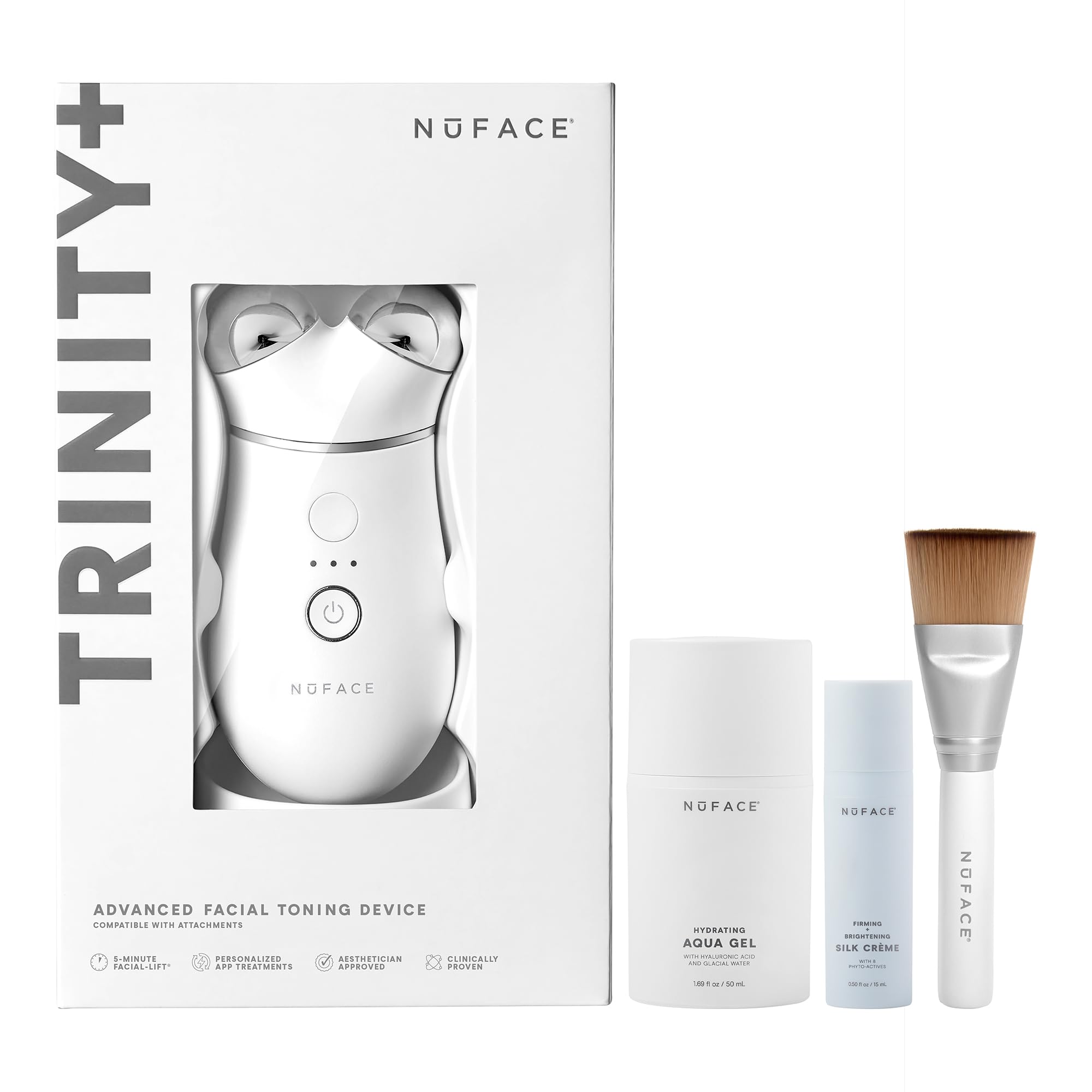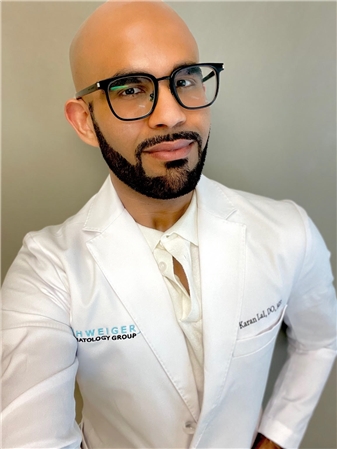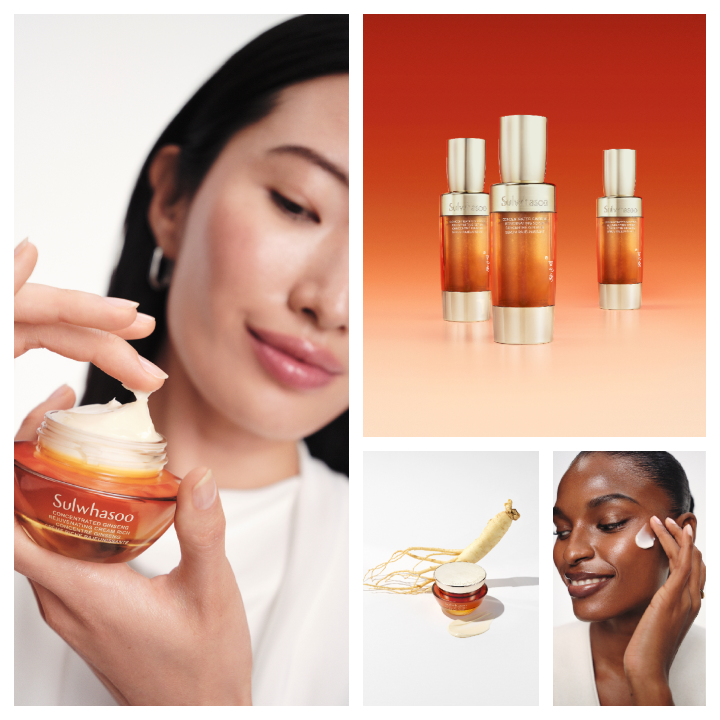The 9 Best Microcurrent Facial Devices for a Sculpted Jawline, Tested by Editors
Give your face a workout.


Taylore Glynn
Not quite ready to get a facelift but can’t bear the idea of wearing your hair in a painfully tight snatched ponytail another day? I get it—we all wanted that lifted look without having to resort to invasive treatments. Enter: the best microcurrent facial devices on the market. While medical-grade machines are used to lift and tone during professional facials, at-home innovations have changed the game. Brands like NuFace, Foreo, and ZIIP (to name a few) have whipped up handheld tools that deliver similar contouring results.
"Microcurrent therapy uses low-level electric voltage to stimulate the muscles in the face," explains board-certified dermatologist Karen Lal, M.D. FAAD. It feels a little bit like an under-the-skin twitch, but the thought is that it’s like a little workout for your facial muscles. The result? A tighter-looking, more sculpted complexion.
But at-home microcurrent devices are expensive. If you’re going to shell out a couple hundred dollars, you want to be sure that the tool is worth the hype—and know exactly how to use it. And yes, you have to use it consistently to see results. Below, I explain exactly what microcurrent devices do, who they work best for, how to incorporate them into your skincare routine, and the best at-home microcurrent devices to shop.
The Best Microcurrent Facial Devices
- Best Microcurrent Device Overall: ZIIP Nano Current Device
- Best Microcurrent Device for Lines: NuFace FIX MicroWand
- Best Multi-Use Microcurrent Device: TheraBody Theraface Pro

This is an editor-favorite at Marie Claire, and for good reason: Designed by a combination of scientists, doctors, and skin experts, the Ziip is a standout in the category. It leverages different wavelengths of nano current waveforms to target a variety of concerns, ranging from fine lines to skin texture to acne. Because all the science and tech talk can be a tad confusing, the brand launched an accompanying app to walk you through exactly what to do. The best part? Results are visible after three treatments.
FDA Cleared: Yes
Intensity Levels: One
Conductive Gel: Yes
Time It Takes to Charge: Four hours
What I Love: Fast-Acting; Easy to hold; Accompanying app
What I Don’t: Expensive
Review for MC: "Sleek, slim, and sophisticated, the ZIIP Halo is the gold-standard in at-home microcurrent. Its ergonomic shape is perfect for sliding and gliding into the curves and creases of the face, and if you're in too much of a hurry for the easy-to-use ZIIP app, you can stick to the four-minute routine the device is programmed for. I was afraid it would hurt a little after hearing how powerful it was, but it was as comfortable as it was effective. My cheeks were left a little more chiseled than they started, a perk I'll never get tired of." — Taylore Glynn, Contributing Beauty Writer

Taylore Glynn using the Ziip.

NuFace's newest launch is all about the details. With three settings specifically curated for sculpting the eyes, plumping lips, and minimizing lines, plus a three-minute run-time, the FIX Microwand is ideal for busy mornings or on the go. The accompanying conductive gel is specifically formulated for treating crows feet, forehead wrinkles, nasolabial folds, and the lip area. While the effects are more obvious the more you use it, the device's results are pretty much instant.
FDA Cleared: Yes
Intensity Levels: Three
Conductive Gel: Yes
Time It Takes to Charge: Four hours
What I Love: Easy to use; Speedy; Multi-use; Treats lines; Travel-friendly
What I Don’t: Can't be used on entire. face
Review for MC: "I'll admit that I'm not the most diligent when it comes to using skin-care devices on a regular basis. Halting my morning to set up an electronic tool, prep my skin for it, and spend a quarter of an hour using it can feel like a time suck, but this device has officially turned me into a devotee. Its three-minute treatment time is a major selling point for me, and so is the instant plumping I noticed each time I used it. I especially like the blurring effect it has on my nasolabial folds, which look smoother under makeup each time I use the device." — Taylore Glynn, Contributing Beauty Writer

The NuFace Microcurrent Wand is perfect for the little details.

While TheraBody is most well known for their percussive therapy, their new TheraFace does also contains a microcurrent attachment. Marie Claire has reviewed the TheraFace extensively, and I also believe that it’s a great bargain. It really is like four different devices (percussive therapy, red light, blue light, and microcurrent) in one. The microcurrent ring needs to be used in tandem with the conductive gel and can be placed on three different settings. The highest setting is generally very tolerable, but it’s totally up to you.
FDA Cleared: Yes
Intensity Levels: Three
Conductive Gel: Yes
Time It Takes to Charge: Two hours
What I Love: Multi-use; Powerful; Easy to use
What I Don’t: Not the most powerful microcurrent
Review for MC: "I have essentially no complaints about TheraBody's facial device. While it's not the most powerful addition to this list, I have sensitive skin, so I'm just fine with the three levels it offers. It's ergonomic and comfy to hold while wielding it around my cheekbones and jaw, and while it's tough to tell in photos, I definitely noticed a sculpted effect right after use. And yes, it's pricy, but this device's versatility really makes it a bang-for-your-buck." — Taylore Glynn, Contributing Beauty Writer

Microcurrent is just one of the Theraface's perks.
Other Microcurrent Facial Devices I Love

I'd be remiss not to include the upgraded version of the brand's classic device on this list. It’s larger than most devices of its kind, which means it’s going to cover more surface area and glide more naturally along the chin and cheek contours. The Trinity+ also packs more power and precision than its predecessor thanks to its Boost button, which cranks up the microcurrent by 25 percent for areas that need extra toning and lifting. And it also comes with an app that offers tutorials and a selfie tracker to keep tabs on progress.
FDA Cleared: Yes
Intensity Levels: Three (plus Boost function)
Conductive Gel: Yes
Time It Takes to Charge: Eight hours
What I Love: Powerful; Treats full face; Contours
What I Don’t: Gel can be drying
Customer Review: "I have been using my NuFace for a few weeks. I can't start my morning routine without it now! I see instant results and have noticed the long-term results, as well: less lines and I feel my face looks more lifted. The app is amazing! Love how you can customize it and follow along step by step. Takes all the guessing out of it." — Sephora

Face Gym’s whole ethos is to work out your face in the same way you would work out your body—and that’s exactly what this tool does. While it does come at a high price point, it’s warranted. This baby has the most options on the market, with 10 different intensities of EMS (electronic muscle stimulation) to choose from. The prongs fit perfectly along the facial contours, including the brow area, and contract muscles like nothing else. You will want to apply a hefty amount of the conductor gel before you get to work. Once that’s said and done, just focus on each area you’d like to lift for around 30 seconds.
FDA Cleared: Yes
Intensity Levels: 10
Conductive Gel: Yes
Time It Takes to Charge: Two to 12 hours
What I Love: Customizable; Treats full face; Good for mature skin
What I Don’t: Very expensive
Customer Review: "Excellent product. This small, handheld device packs quite a punch and results are quick and clear. Not only do my jawline and eyes look lifted, but my skin tone is improved and my wrinkles appear less noticeable. Highly recommend!" — FaceGym

If this duel-handled device looks like something you'd find bedside at a spa, you're not far off. Myolift's adjustable tool is as close as you can get to a professional-grade microcurrent device at home. Though it requires a little extra dexterity—you'll need to use both hands here—it's worth it for the contouring and sculpting power it provides.
FDA Cleared: Yes
Intensity Levels: One (adjustable)
Conductive Gel: Yes
Time It Takes to Charge: Rechargable battery lasts up to three months
What I Love: More precision; Contouring; Similar to esthetician equipment
What I Don’t: Requires more dexterity
Customer Review: "I am a professional who has had some training from different microcurrent companies and I have to say: I love this device. It's easy to use and completely affordable! Yes, there is an initial investment, but you recoup your investment very easily. It's a fantastic option for my clients to be able to continue treating their skin at home. I couldn't be happier with it." — 7e Wellness

Sometimes, straightforward is best, and this is one of those occasions. Skim Gym's device couldn't be easier to use: strategic beeps prompt you to slide the tool into hyper-specific locations all over the face to make contouring easy. The pronged head makes it especially handy for sculpting the brow and jaw areas.
FDA Cleared: No
Intensity Levels: Five
Conductive Gel: Yes
Time It Takes to Charge: None, requires AA batteries
What I Love: Affordable; Easy to use
What I Don’t: Not FDA-cleared
Customer Review: "With regular use, I've noticed a significant improvement in the firmness and elasticity of my skin. Portable, small, cute, and great packaging. Love it!" — SkinGym

Chances are, you’ve seen this little LED light therapy device before. Reese Witherspoon, Sydney Sweeney, and Nicole Kidman have all showed it off social media. It’s smaller and easier to travel with than the other options but still packs in powerful technology. The device's galvanic current will help tighten and lift—but that’s just the start. This little guy also features red light therapy to fade discoloration, a massage feature that reduces puffiness, and a nice warming technology that will push your skincare products deeper into the skin.
FDA Cleared: Yes
Intensity Levels: 1
Conductive Gel: Yes
Time It Takes to Charge: Two hours
What I Love: Affordable; Multiple benefits
What I Don’t: Not ultra-powerful
Customer Review: "I've been using for several weeks and have noticed a difference, especially a healthy glow. Not sure if it's worked for wrinkles yet, but definitely for circulation and bringing out a rested look. Love it; easy to use. I do add a few drops of rosehip oil for better slip, as the serum does dry quickly." — Solawave

First and foremost: I’m obsessed with this hot pink shade. It’s designed with a special Anti-Shock System, which makes the whole microcurrent process a lot less, well, twitchy. It’s also completely customizable, with five different intensities to choose from. Alas, it gets better: the Foreo comes with an app login that gives everyone access to guided treatments, FAQs, and in-depth tutorials.
FDA Cleared: Yes
Intensity Levels: 1
Conductive Gel: Yes
Time It Takes to Charge: Two hours
What I Love: Powerful; Customizable; Comes with an app
What I Don’t: Bulky
Customer Review: "Easy to use it, and after the third use, I could see improvements. The serum has a nice smell, too, and it's suitable for sensitive skin use. I recommend to all!" — Amazon
The Benefits of Microcurrent Therapy
As time goes on, the muscle system that coordinates our facial expressions becomes weaker, leading to sagging and drooping. "This therapy stimulates the muscle system, causing the muscles to perk up. This therapy is often used in physical therapy and has been shown in studies to promote wound healing," Dr. Lal says.
While an in-office treatment will offer more dramatic results, regular at-home microcurrent treatments can result in tighter, more lifted-looking skin.
How to Use an At-Home Microcurrent Device
While instructions for how to use microcurrent facial devices will vary from product to product, there are a few commonalities. You'll always want to start with clean skin. After washing your face, apply the conductive gel that accompanies your tool. The jelly-like activator is key—it helps the microcurrent reach your muscles.
How Long Does It Take for At-Home Microcurrent Therapy to Work?
It's important to manage expectations when using a microcurrent device. While consistent use over time will create a lifted appearance, the results are not permanent. If you're looking for a one-and-done solution or dramatic fix, a face lift or injections are likely better options.
"Most facial massages will decrease inflammation, swelling, and provide some level of lift, all of which is temporary," says Dr. Lal. "Just like exercise, gains aren’t made overnight and persistence is key."
The Difference Between At-Home and In-Office Treatments
"In office treatments are expensive and results are transient," warns Dr. Lal. "Most practitioners recommend a series of beginning treatments followed by maintenance treatments and the cost adds up."
While at-home devices aren't as powerful or targeted as in-office facials, they'll likely save you money in the long run. "For people who are persistent, they may prove to be more economical than in-office treatments," Dr. Lal says.
The Risks of Microcurrent Therapy
Microcurrent therapy is considered "relatively safe," according to 2021 research, and is pretty painless. But it's important to make sure you're still keeping up with the rest of your skincare routine. "People who have perfected creating a skincare regimen with SPF, a retinoid, and antioxidants that are looking for a low-risk way of improving skin firmness are good candidates for microcurrent therapy," says Dr. Lal.
Meet the Experts

Dr. Karan Lal is a board-certified dermatologist. Originally from New York City, he grew up in Queens and attended Hunter Science High School in Manhattan. He graduated summa cum laude from the New York Institute of Technology, where he completed a rigorous seven-year accelerated combined medical program. He was selected to be an academic medical scholar, during which he received a Master of Science in neuroscience and a scholarship for three years of medical school and graduate training. He was elected to the Sigma Sigma Phi and Psi Sigma Alpha medical honor societies. He completed his internal medicine internship at the University of Connecticut Medical Center where he was elected intern of the year. He completed a three-year dermatology residency at the University of Massachusetts, where he was elected chief resident. He continued on at the University of Massachusetts to complete a pediatric dermatology fellowship, where he gained an interest in vascular anomalies, pediatric laser, and dermatologic surgery of pediatric patients. Dr. Lal specializes in pediatric and adult dermatology, laser surgery, soft tissue filler augmentation, body sculpting, pigmentary abnormalities of the skin and enjoys treating patients from birth onwards.
Stay In The Know
Get exclusive access to fashion and beauty trends, hot-off-the-press celebrity news, and more.

Samantha Holender is the Senior Beauty Editor at Marie Claire, where she reports on the best new launches, dives into the science behind skincare, and shares the breakdown on the latest and greatest trends in the beauty space. She's studied up on every ingredient you'll find on INCI list and is constantly in search of the world's glowiest makeup products. She's constantly tracking the biggest nail and hair trends to pop up in the beauty space, going backstage during fashion weeks, tracking celebrity looks, and constantly talking to celebrity hair stylists, nail artists, and makeup artists. Prior to joining the team, she worked as Us Weekly’s Beauty and Style Editor, where she stayed on the pulse of pop culture and broke down celebrity beauty routines, hair transformations, and red carpet looks. Her words have also appeared on Popsugar, Makeup.com, Skincare.com, Delish.com, and Philadelphia Wedding. Samantha also serves as a board member for the American Society of Magazine Editors (ASME). She first joined the organization in 2018, when she worked as an editorial intern at Food Network Magazine and Pioneer Woman Magazine. Samantha has a degree in Journalism and Mass Communications from The George Washington University’s School of Media and Public Affairs. While at GWU, she was a founding member of the school’s HerCampus chapter and served as its President for four years. When she’s not deep in the beauty closet or swatching eyeshadows, you can find her obsessing over Real Housewives and all things Bravo. Keep up with her on Instagram @samholender.
-
 Demi Moore Proves Her Style Icon Status in a Custom Gap Gown
Demi Moore Proves Her Style Icon Status in a Custom Gap GownShe's a champion of affordable luxury.
By Lauren Tappan
-
 Olivia Rodrigo Turns Gucci's Horsebit 1955 Bag Into a Dress
Olivia Rodrigo Turns Gucci's Horsebit 1955 Bag Into a DressAn award-winning look for an award-winning night.
By Kelsey Stiegman
-
 Blake Lively Pays Tribute to Her Own Met Gala Look
Blake Lively Pays Tribute to Her Own Met Gala LookThe first Monday in May came early this year.
By Kelsey Stiegman
-
 Here's the Skinny on Fat Grafting Skincare Treatments
Here's the Skinny on Fat Grafting Skincare TreatmentsHere's the skinny on the cosmetic treatment taking over plastic surgeons' offices from coast-to-coast.
By Fiorella Valdesolo
-
 Everything You Need to Know About Marie Claire’s Skin and Hair Awards
Everything You Need to Know About Marie Claire’s Skin and Hair AwardsCould your brand survive an editor testing session?
By Ariel Baker
-
 People Always Compliment My Flawless Skin—These 6 Steps Are Why
People Always Compliment My Flawless Skin—These 6 Steps Are WhyFrom sunscreen and essences to moisturizers, it's all here.
By Hannah Baxter
-
 The 11 Best Spring Makeup Trends Are Sexy, Sensual, and Perfectly Luminous
The 11 Best Spring Makeup Trends Are Sexy, Sensual, and Perfectly LuminousIt's dew or die time.
By Jamie Wilson
-
 Simone Ashley’s Indie Sleaze Glam Is a Cool-Toned Dream
Simone Ashley’s Indie Sleaze Glam Is a Cool-Toned DreamThe actor was spotted in New York City looking like the epitome of cool-toned beauty.
By Ariel Baker
-
 Sulwhasoo’s New Concentrated Ginseng Cream Is a Wrinkle-Erasing Time Machine for My Skin
Sulwhasoo’s New Concentrated Ginseng Cream Is a Wrinkle-Erasing Time Machine for My SkinThis Seoul-based brand is the key to plump skin.
By Samantha Holender
-
 The 10 Best Hair Growth Shampoos of 2025, Tested by Editors
The 10 Best Hair Growth Shampoos of 2025, Tested by EditorsExpensive and healthy-looking hair on lock.
By Marisa Petrarca
-
 New York Fashion Week’s Fall/Winter 2025 Best Beauty Moments Are a Lesson in Juxtaposition
New York Fashion Week’s Fall/Winter 2025 Best Beauty Moments Are a Lesson in JuxtapositionThe week's best beauty looks were a maximalism master class.
By Ariel Baker